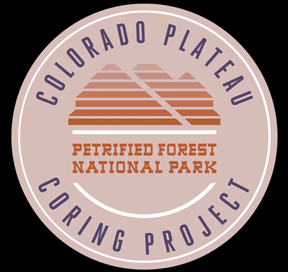
Description
The Petrified Forest Core of the
CPCP involves drilling a continuous a ~500 m core through nearly the
entire Triassic age section (Chinle and Moenkopi formations) at
Petrified Forest National Park (PFNP), Arizona, USA, one of the most
famous and best studied successions of the continental Triassic in the
World. A core is needed to place this spectacular record in a reliable
quantitative and exportable time scale, which has proved impractical in
outcrop. The Petrified Forest core will provide a quantitatively sound
reference section in which magnetostratigraphic, geochronological,
environmental, and paleontologic data are registered to a common
thickness scale with unquestioned superposition and will provide
pristine unweathered samples. With such a reference section in hand the
entire massive assemblage of outcrop data from the PFNP and the
surrounding region can be integrated into the global framework. The
hole will be deviated 30° from vertical for core-bedding orientation
intersections to be used as an azimuthal guide; additionally, the
orientation of the core will be registered to the hole wall using
whole-core-scans and compass-oriented acoustic and optical televiewer
images and dipmeter surveys. Core orientation will facilitate the
recovery of a high-resolution magnetic polarity stratigraphy for
correlation to the fossil-rich outcrop sections. The polarity sequence
will be calibrated by a series of high-precision U-Pb zircon dates
obtained from discrete levels in the core, and provide critical data to
fill the geochronologic gap in global time scales for the Late Triassic.
The
age-calibrated chronostratigraphy of the PFNP core will be used to
address major issues of early Mesozoic biotic and environmental change including;
1) Were marine and continental biotic turnover events in the Late
Triassic coupled? 2) Was the largest magnitude faunal turnover event on
land during the Late Triassic synchronous with the giant Manicouagan
bolide impact? 3) Does the NSF-funded Newark basin
astronomically-calibrated Newark Basin time scale based on the NSF funded Newark Basin Coring Project fit independent radioisotopic
dates from the Chinle Formation? 4) Is the orbitally forced (Milankovitch) cyclical climate change
recorded in the Newark basin lacustrine reflected in the largely fluvial Chinle and Moenkopi formations?